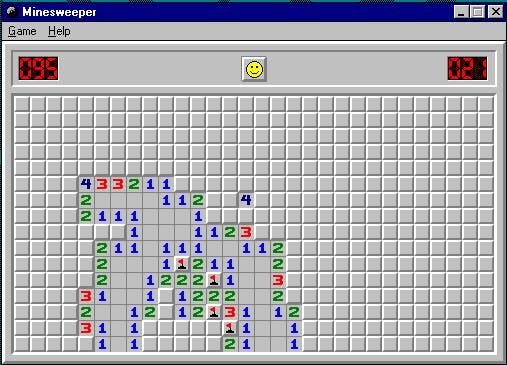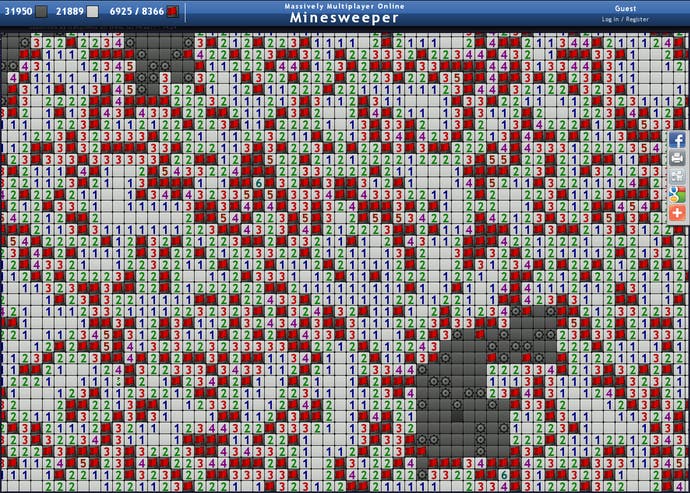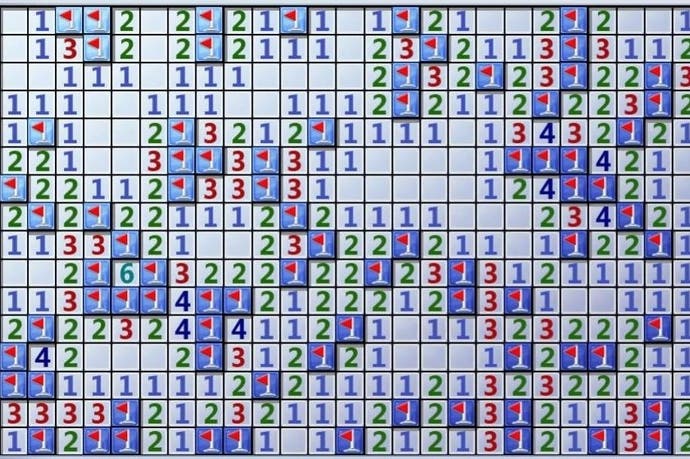Every step you take: The story of Minesweeper
Meeting the original minelayers, and those who keep sweeping.
You know Minesweeper, of course. It's video game wallpaper that's silently seeped into countless people's lives. Everyone can recount the basics; the left-mouse button reveals the contents of a tile whilst the right flags a tile as containing a mine. The levels vary from 8x8 grids up to huge 64x64 grids. There's the smiley face when you do well, the gasp of failure and the cross-eyed look of death when you fare slightly worse. The mechanical logic would make a chess grandmaster grin, while bold gamblers still chase quicker and quicker clearance times.
Minesweeper wasn't the first of its kind. That credit goes to a lesser known, tightly designed game by Ian Andrew. Andrew has had a long career in games which began when, as a child, he'd modify his wooden pinball table with nails and elastic bands. Soon he moved on to the ZX81, and his very first commercial game, Mined-Out.
"Mined-Out was developed partly due to the Sinclair Spectrum's limitations of colour blocks on the screen," Andrew recounts. "You could only have 2 different colours in each 'character square' which was 8 by 8 pixels big. So a block/grid game was a natural for this computer. I was only a Basic programmer so puzzle/thought games were a natural fit as well."

The game was finished in 6 months. "I do remember my very supportive mother testing it for me along the way. I was 24 at the time and running a mail order business from my bedroom. Unusually also at the time only machine code games were available, so a Basic game becoming commercial was unusual." With the generous royalties given by his publisher, Quicksilva, Andrew established his own publishing company, Incentive Software, to make his next game, Splat! "It's another original design that has never been copied, to my knowledge." Mined-Out was, of course, copied - and it's Microsoft's own take on Andrew's formula that's now the better known game. "When I saw Minesweeper, I absolutely thought that it was based on my idea," says Andrew. "I also thought Mined-Out was a much better game for the simple reason that you didn't need to take random chances in Mined-Out like you do have to with Minesweeper."
After making its debut in the Windows Entertainment Pack, Minesweeper was given away with Windows 3.11, the breakthrough version of Windows. It's been a staple ever since, and Windows 8 is the first Microsoft OS since 3.11 that hasn't included it by default. And the men who made that version of Minesweeper were Curt Johnson and Robert Donner.
Over the phone, Johnson's voice is slow. It's so soft and hesitant I keep thinking he's finished speaking mid-sentence, so I start talking before the transatlantic lag reveals he was just taking a long, long moment to sieve his thoughts. When he talks about Minesweeper, he's even slower. I'm happy to wait, as it's taken me months to hunt him down.
Johnson is a self-taught programmer who moved to Microsoft in the early 90s, mainly because the weather was better. "I was here in Minnesota." he says. "It was minus 20 fahrenheit. Exposed skin would freeze in seconds. In Seattle it was a record low, of zero Fahrenheit." Considering his previous job was generating graphs to represent the gaps between the doorframes of Ford cars, he saw it as a step up.
His duty was to maintain a debugger for OS2, but in his spare time he was teaching himself the newly-created art of GUIs. "Minesweeper was my second program, because I had to write a 16 colour bitmap editor to develop the assets used in the program. Microsoft Paint, in those days, used black and white."
Curt comes from the generation where copying ideas was the norm, so is disarmingly honest about borrowing the idea for Minesweeper - but not from Mined-Out. Sadly, he's not sure what the game was called that he did borrow from. "There was a Macintosh game that I had, with black and white images to display all of the cells. I think it was written in Basic and was very slow on an old Mac. I actually still have that Mac, but I haven't turned it on in years. This game required a clear strip of cells from the top left to the bottom right corner. There was also a mainframe game that I played in high school that drew the entire board on paper after each move."

And though Johnson took the basic theme from a Mined-Out derivative, he made substantial changes based on how he played that game. "Your job was to go from the top-left corner to the bottom-right. When I played the game, I would solve as much as I could before I'd step into that corner. So I set it up in Minesweeper so that you'd have to step in all the squares that were unoccupied and didn't care if you'd marked the ones that were." He built the game in C, distributing it as Mines on bulletin boards.
OS2 turned out to be a dead end, and Johnson's attention soon withered; "I got to the point in testing the software that I wasn't that interested in spending a lot of time playing it." So his colleague Robert Donner converted the game to Windows, adding bells and whistles along the way. From there, it took off among Microsoft's employees - Bill Gates himself held the high score on the Beginner mode for some time. From there, the Windows Entertainment Pack, Windows 3.11 and the world were only a few clicks away.
Minesweeper maintains a strong, dedicated following. Damien Moore has been curating this community over at Minesweeper.info for fifteen years. "When I started playing in 1999 it was completely amateur and no one knew what times were possible. There were no maintained rankings, no statistics, no tournaments and no videos. North America and Europe have been the mainstay of sweeping up until the last few years, with the Chinese community taking off in 2007 and now fielding all the best active players (and the best hackers)."
So who's playing at this level? "The vast majority of the top players are taking math or science related degrees at university and tend to be male (roughly 87 per cent of the best players) and between 17 and 25. There was an architect at the top of the rankings once upon a time. Most of the top players also have related hobbies, and there is a strong overlap with the Rubik's Cube world ranking - the top German player recently retired to pursue cubing more seriously. Another two former world number ones showed strong Asperger personalities, which is not surprising."
Given Johnson and Donner's hands-off approach with their creation, it's this maths-head community that's transitioned the game into the most clinical of e-sports. The early years of the game saw players finding all sorts of flaws in the game, which could give players a time advantage. First, were the built-in cheats and hints, though these were taken out by Donner himself. Next, was clock-stopping, where you'd brute-force a computer into slow motion by overloading the processor.

Finally, the players discovered the Dreamboard. Even Johnson cheerily admits he has no idea what the Dreamboard is, or why it's there. Essentially, the random number generator at the heart of Minesweeper has a flaw when dealing with square boards, such as the Beginner and Intermediate level, which makes successive games eventually fall into one of four repetitive cycles. The Dreamboard was the 4232 board in the 12096 board cycle. The discovery of this fundamentally changed Minesweeper.
Moore explains. "Back in 2000, the top player at the time noticed two of the best players had submitted the same board, and examination of other records eventually led to the discovery of board cycles. Of course, many players memorised the game after watching videos of it being played and analysed the best way to solve it, leading to players navigating to the board, taking a deep breath, and then playing it from memory. Someone scored 6 seconds on it, and all this unfair prior knowledge led to the original version being banned."
Given these flaws, the original games have been long been abandoned, with three specialised versions now available. Minesweeper X is a 60kb clone of the original, with better randomisation and automatic recording. Arbiter is similar, but produces customisable statistical graphs of your gaming history, and is the most popular. And Viennasweeper is a tournament clone, which automatically uploads games to a website based on the parameters set by the tournament organiser. A community-agreed rating system - 3BV/s - which measures the number of clicks necessary to complete a board per second.
So much for the hardcore community. Minesweeper is ubiquitous though. There's a version in Runescape called Vinesweeper. Over in France, another Minesweeper fan has just released his own version, a Minesweeper MMO called 'A Few Billion Squares' which is oddly reminiscent of Molyneux's failed Curiosity experiment.
Johnson doesn't seem to have any regrets about the game, and in his slow drawl you detect a mild pride that matches his understated feelings towards the harsh Minnesota winters. I tell him of the history of the game, and of its many legacies. He doesn't seem moved, one way or another. But then I tell him about the Windows 2000 Minesweeper that was met in Italy by a moral storm, the media concerned about the game's unnecessarily violent theme. Microsoft eventually relented and renamed the game Prato Fiorita. On hearing, Johnson gets briefly animated. "Would I come up with a game called Minesweeper today? No, for the reason they described," he says, before dwelling on the English translation of the name. "Field of flowers, though? It's a fine name."

